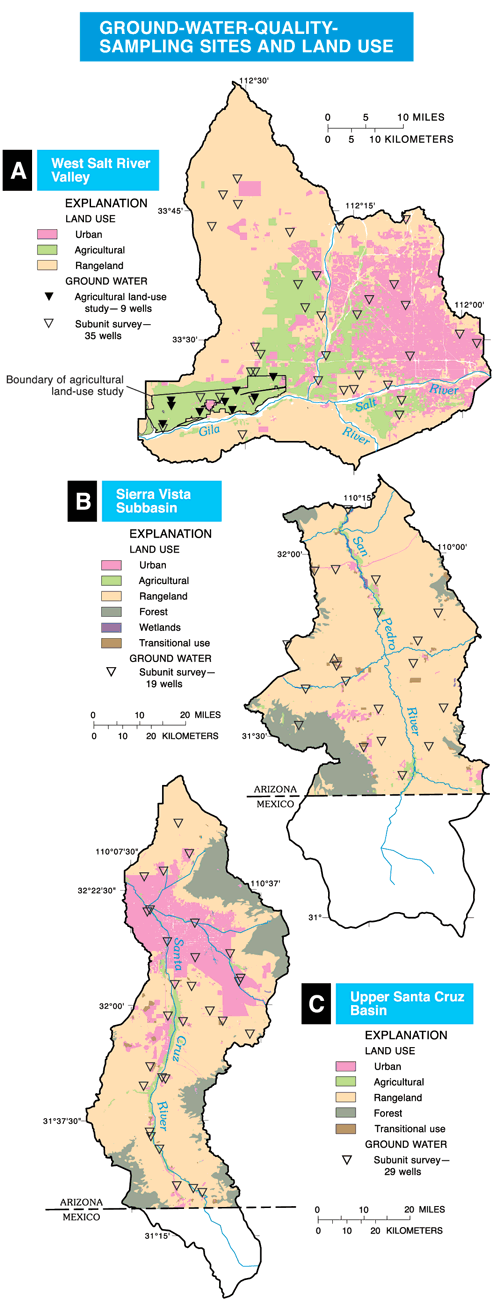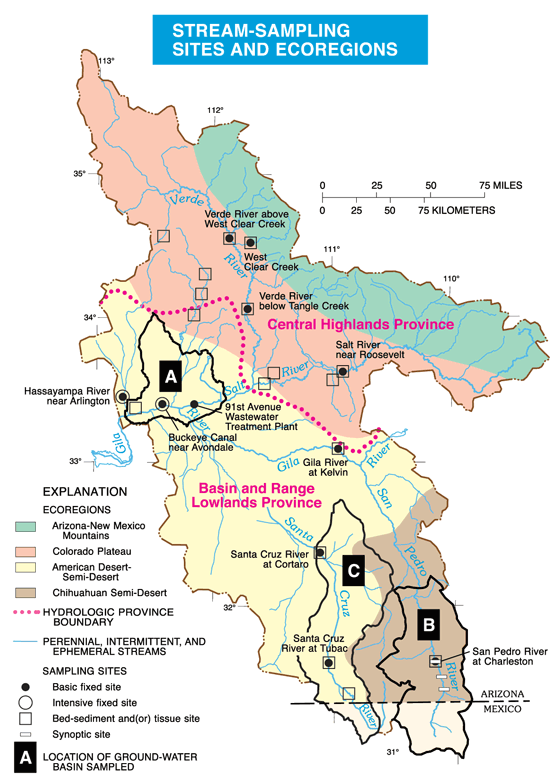STUDY UNIT DESIGN
The Central Arizona Basins study was designed to provide nationally comparable water-quality data and address local and national questions about water quality. The primary goal of the study was to understand the human and natural factors that affect the chemistry of ground and surface water and communities of aquatic organisms.
Surface-water chemistry and biological-sampling sites were divided between the two main hydrologic provinces in the study area: the Central Highlands and the Basin and Range Lowlands (see below). Ground-water samples were collected in three basins in the Basin and Range Lowlands. Human activities were least in the Sierra Vista subbasin, greatest in the West Salt River Valley, and intermediate in the Upper Santa Cruz Basin. Effects of agricultural activities on ground water were studied in the western part of the West Salt River Valley.
 |
 |
|
Study |
What data were collected and why |
Types of sites sampled |
Number of sites |
Sampling frequency and period |
|---|---|---|---|---|
| Stream Chemistry |
||||
| Basic fixed sites, general water quality |
Streamflow, dissolved oxygen, pH, alkalinity, specific conductance, temperature, nutrients, major ions, organic carbon, and suspended sediment were measured to determine occurrence and distribution. |
Streams selected to represent urban, mixed agricultural/urban, and forest/rangeland land uses were distributed throughout the study area. Basins ranged from 0 miles (at point sources) to 18,011 square miles. |
9 |
Monthly plus high flows |
| Intensive fixed sites |
Above constituents plus 87 pesticides and 85 volatile organic compounds. |
Sites selected closer to urban and (or) agricultural areas so as to be more likely to reflect those land uses. |
2 |
Monthly Jan. 1996-Dec. 1996, increased sampling frequency to approximately twice a month Dec. 1996-Feb. 1998 |
| Fixed sites, |
Spectral characteristics of dissolved organic carbon from surface water were measured to determine sources. |
Same sites as basic fixed sites and intensive fixed sites. |
11 |
Monthly Jan. 1996- August 1997 |
| Synoptic |
Same as basic fixed sites, plus pesticides. |
Three locations collocated with key sites for stream ecology synoptic. |
3 |
Quarterly |
| Contaminants in bed sediment |
Trace elements and (or) organic compounds to determine occurrence and distribution in streambed sediments. |
Depositional zones of most basic and intensive stream-chemistry sites plus additional sites. |
17 |
Once |
| Contaminants in tissues of aquatic biota |
Trace elements and (or) organic compounds to determine occurrence and distribution in tissues of fish, clams, and crayfish. |
Same sites as sediment samples. |
15 |
Once
|
| Stream Ecology |
||||
| Basic sites |
Communities of algae, invertebrates, and fish; and instream and riparian habitats surveyed to assess biological conditions of the study area. |
Sites collocated with most basic and intensive stream-chemistry sites. |
7
|
Once Oct. 1995-Jan. 1996 Annually 1995-1997 |
| Synoptic |
Communities of algae, invertebrates, and fish; and instream and riparian habitats surveyed to evaluate spatial variability. |
Nine reaches along one segment of a stream with minimal anthropogenic influences. |
9 |
Once |
| Ground-Water Chemistry |
||||
| Study Unit West
Salt River Valley- |
Nutrients, major ions, trace elements, volatile organic compounds, radon, dissolved organic carbon, and pesticides to assess water quality of the basin's aquifers. |
Existing domestic, public-supply, irrigation, livestock, and industrial wells. |
35 |
Once
|
| Study Unit Upper Santa Cruz Basin- mixed land use |
Nutrients, major ions, trace elements, volatile organic compounds, radon, dissolved organic carbon, and pesticides to assess water quality of the basin's aquifers. |
Existing domestic, public-supply, irrigation, livestock, and industrial wells. |
29 |
Once
|
| Study Unit Sierra Vista subbasin- mixed land use |
Nutrients, major ions, trace elements, volatile organic compounds, radon, dissolved organic carbon, and pesticides to assess water quality of the basin's aquifers. |
Existing domestic, public-supply, irrigation, and livestock wells. |
19 |
Once
|
| Land use |
Nutrients, major ions, trace elements, volatile organic compounds, radon, dissolved organic carbon, and pesticides to determine effects of agricultural land use on shallow ground-water quality. |
Shallow monitoring wells. |
9 |
Twice |
| Table of Contents || Previous Section || Next Section || Glossary U.S. Geological Survey Circular 1213 Suggested citation:
|

